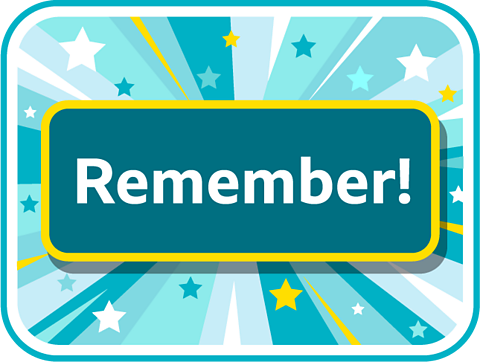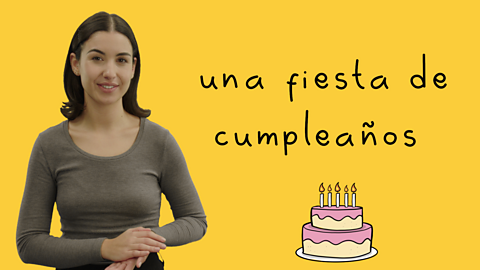Introducing yourself in Spanish.
Hello!
¡Hola!
How are you?
¿Qué tal?
Bien, gracias, ¿y tú?
When you meet somebody, they might ask you what you’re called.
¿Cómo te llamas?
And when they ask you that question, you say me llamo.
Me llamo Álvaro.
In Spanish you use exclamation and question marks at the beginning and at the end of sentences, like this.
Notice that they're upside down at the start of the sentence.
If you want to talk about yourself a bit, the verb tener, ‘to have’, is really useful.
In Spanish you use tengo, ‘I have’, to say how old you are.
Tengo dieciocho años.
Which literally means ‘I have 18 years’.
Another really useful word is dónde - 'where'.
You could ask ‘where do you live?’
¿Dónde vives?
You might answer Vivo en Swansea - ‘I live in Swansea’.
When it’s time to say ‘goodbye’, you could say ¡Adiós!
If you want to say ‘see you later’, it’s ¡Hasta luego!

Greetings
It is polite to greet people when you see them for the first time that day, using these phrases:
- ¡Hola, buenos días! - Hello, good morning!
or
- Buenas tardes, ¿cómo estás? - Good afternoon, how are you?
When you want to say 'goodbye' to someone, you can say:
- ¡Adiós! - Goodbye!
or
- Buenas noches, hasta mañana - Good night, see you tomorrow.

In English, we normally use ‘good afternoon’ after midday, but in Spanish you would not start to use buenas tardes until after lunch, which is typically any time after 13:00.
You use buenas noches as ‘good evening’ when it is dark.
You can also use buenas noches as ‘good night’ when you go to sleep.
Here are some words you can use. Can you create a dialogue to greet someone?
| Spanish | English |
|---|---|
| hola | hello |
| adiós | goodbye |
| buenos días | good morning |
| buenas tardes | good afternoon |
| buenas noches | good evening/good night |
| hasta luego | see you later |
| hasta mañana | see you tomorrow |
Asking how someone is
To ask someone how they are, you can say either of the following:
- ¿Cómo estás? - How are you?
or
- ¿Qué tal? - How are you?
¿Qué tal?
How are you?
And reply by saying estoy (I am) followed by an adjective to describe how you are feeling.
For example:
- Estoy bien, gracias. ¿Y tú? - I am well, thank you, and you?
Estoy bien, gracias. ¿Y tú?
I am well, thank you, and you?

Adjectives are words used to describe people, places or things.
Here are some useful words and phrases to talk about how you are feeling.
| Spanish | English |
|---|---|
| ¿Cómo estás?/¿Qué tal? | How are you? |
| Estoy bien | I am well |
| Estoy muy bien | I am very well |
| Estoy mal | I am not good/I am bad |
| Estoy muy mal | I am very bad |
| Estoy así así/regular | I am so-so |
| ¿Y tú? | And you? |

Saying your name
You can ask someone their name by saying:
- ¿Cómo te llamas? - What is your name?
And reply with:
- Me llamo… - I am called…
Listen to this conversation.
Can you adapt it to talk about yourself?
Check your understanding by looking in the Audio Transcript box.
Ana - ¿Cómo te llamas? (What is your name?)
Hamza - Me llamo Hamza. ¿Y tú? ¿Cómo te llamas? (My name is Hamza. And you? What is your name?)
Ana - Me llamo Ana. (I am called Ana.)
You can also ask what someone else is called by using ¿Cómo se llama? - What is his/her name?
For example:
¿Cómo se llama tu hermana? - What is your sister called?
Mi hermana se llama Mariam - My sister is called Mariam.
Listen to this conversation.
Can you adapt it to talk about yourself?
Check your understanding by looking in the Audio Transcript box.
¿Cómo se llama tu hermana? - What is your sister called?
Mi hermana se llama Mariam. - My sister is called Mariam.
Here are some useful questions and verbs to ask and answer about your or different people’s names.
| Spanish | English |
|---|---|
| ¿Cómo te llamas? | What is your name? |
| ¿Cómo se llama tu hermano? | What is your brother's name? |
| Me llamo | I am called |
| Te llamas | You are called |
| Se llama | He/She/It is called |
Asking ages
You can ask someone’s age by asking:
- ¿Cuántos años tienes? - How old are you?
and replying with tengo (number) años.
For example:
- Tengo trece años – I am thirteen years old.
Note that in Spanish, you use the verb tener (to have), so when translated literally you say how many years you have.
Listen to this conversation.
Can you adapt it to talk about yourself?
Check your understanding by looking in the Audio Transcript box.
¿Cuántos años tienes? - How old are you?
Tengo doce años. - I am twelve years old.
Talking about where you live
You can ask someone where they live by asking:
- ¿Dónde vives? - Where do you live?
and reply with:
- Vivo en (I live in) followed by a country, town or city.
For example:
¿Dónde vives? - Where do you live?
Vivo en Blackpool en Inglaterra - I live in Blackpool in England.
Listen to this conversation.
Can you adapt it to talk about yourself?
Check your understanding by looking in the Audio Transcript box.
¿Dónde vives? - Where do you live?
Vivo en Blackpool en Inglaterra. - I live in Blackpool in England.
Use this table to see how to say different countries or cities.
Most cities are exactly the same in Spanish, except for London, Manchester and Edinburgh.
| Spanish | English |
|---|---|
| ¿Dónde vives? | Where do you live? |
| Vivo en… | I live in… |
| Inglaterra | England |
| Escocia | Scotland |
| Gales | Wales |
| Irlanda del Norte | Northern Ireland |
| Irlanda | Ireland |
| España | Spain |
| Londres | London |
| Mánchester | Manchester |
| Edimburgo | Edinburgh |
Talking about your nationality
You can find out somebody’s nationality by asking:
- ¿Cuál es tu nacionalidad? - What is your nationality?
You can reply with soy (I am) followed by an adjective.

Adjectives of nationality need to agree with the person whose nationality is being described.
For example:
¿Cuál es tu nacionalidad? - What is your nationality?
Soy alemán - I am German (male).
¿Cuál es tu nacionalidad? - What is your nationality?
Soy ruman_a_ - I am Romanian (female).
¿Cuál es tu nacionalidad? - What is your nationality?
Soy mitad escoces_a_ y mitad polac_a_ - I am half Scottish and half Polish (female).
Remember that you don't need a capital letter with nationality in Spanish.
Look at the table below to see more examples of other nationalities.
Think about the masculine version and the feminine version of the adjective.
Remember, you must drop the accent in the feminine versions of the adjectives, for example inglés and inglesa, or escocés and escocesa.
| Spanish | English |
|---|---|
| ¿Cuál es tu nacionalidad? | What nationality are you? |
| Soy… | I am… |
| inglés/ingles_a_ | English |
| escocés/escoces_a_ | Scottish |
| irlandés/irlandes_a_ | Irish |
| galés/gales_a_ | Welsh |
Have a look at this downloadable vocabulary list to see more useful words you can use to talk about age and nationality
Saying please and thank you
It is always nice to use your manners when speaking in Spanish, by saying por favor (please), gracias (thank you) and de nada (you're welcome).
Listen to the audio to hear how to pronounce these words.
Clara - ¿Cómo se llama tu madre, por favor? - What is your mother called, please?
Luís - Mi madre se llama Sofía - My mother is called Sofía.
Clara - Gracias - Thank you.
Luís - De nada - You’re welcome.
Quiz
Find out how much you know about introductions in Spanish in this short quiz!
GCSE exam dates 2025
Find out everything you need to know about the 2025 GCSE exams including dates, timetables and changes to exams to get your revision in shape.

More on Topics
Find out more by working through a topic
- count4 of 9

- count5 of 9

